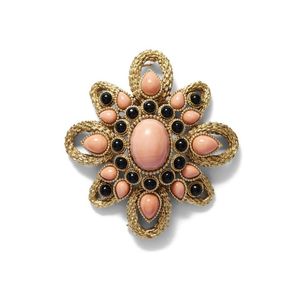Boucheron Serpent Boheme Coral and Onyx Pendant/Brooch, Circa 1970
Boucheron coral and onyx 'Serpent Boheme' pendant/brooch, circa 1970, property from a private Victorian Collector, centring an oval cabochon coral framed by a beaded surround further decorated by circular cabochon onyx and pear shaped coral between openwork textured coiled serpentine motifs, length 78 mm, width 72 mm, numbered 2xxx6, signed Boucheron Paris., notes: in 1888, Frederic Boucheron gifted his wife a serpent necklace, a symbol of enduring protection. This romantic gesture birthed the iconic serpent motif that has become the hallmark of the house. The serpent Boheme collection, unveiled in 1968, transcends time with its poetic elegance, a graceful dance through the tapestry of ages., condition: *CITES permit required for export.
You must be a subscriber, and be logged in to view price and dealer details.
Subscribe Now to view actual auction price for this item
When you subscribe, you have the option of setting the currency in which to display prices to $Au, $US, $NZ or Stg.
This item has been sold, and the description, image and price are for reference purposes only.
- Circa - A Latin term meaning 'about', often used in the antique trade to give an approximate date for the piece, usually considered to be five years on either side of the circa year. Thus, circa 1900 means the piece was made about 1900, probably between 1895 and 1905. The expression is sometimes abbreviated to c.1900.
- Onyx - Onyx is a form of agate, used from antiquity and popular again in the 1920s and 30s. European onyx is generally green, but can be many other colours, and can contain bands of black and/or white.
This multicoloured stone is widely used for table tops, lamp bases and in jewellery. Some types of onyx are also used for cameos of which the upper white layer is cut away to reveal the colour beneath. - Victorian Period - The Victorian period of furniture and decorative arts design covers the reign of Queen Victoria from 1837 to 1901. There was not one dominant style of furniture in the Victorian period. Designers used and modified many historical styles such as Gothic, Tudor, Elizabethan, English Rococo, Neoclassical and others, although use of some styles, such as English Rococo and Gothic tended to dominate the furniture manufacture of the period.
The Victorian period was preceded by the Regency and William IV periods, and followed by the Edwardian period, named for Edward VII (1841 ? 1910) who was King of the United Kingdom and the British Dominions and Emperor of India for the brief period from 1901 until his death in 1910. - Cabochon Cut in Jewellery - A cabochon cut is a type of gemstone cutting where the stone is cut and polished in a convex shape with a flat bottom and a domed top, with no facets. This type of cut is typically used for opaque or translucent stones that have natural patterns or inclusions that are best displayed in this type of cut. Examples of stones that are often cut as cabochons include turquoise, opal, and moonstone.
- Openwork in Jewellery - Openwork, also known as pierced work, is a decorative technique used in jewellery making that involves removing or cutting out sections of metal from a piece of jewellery to create a pattern or design. This technique can be used in a wide range of jewellery styles, including necklaces, bracelets, earrings, and rings.
Openwork jewellery can be made using a variety of different techniques, including hand carving, sawing, and laser cutting. The design can be simple or complex, and can feature a range of different shapes and motifs, from delicate floral patterns to bold geometric designs.
One of the advantages of openwork jewellery is that it can add visual interest and depth to a piece without adding a lot of weight or bulk. This can be particularly appealing in larger pieces, such as necklaces and bracelets, where heavy materials can be uncomfortable to wear. - Coral - Coral used in jewellery. Coral is a material that is commonly used in jewellery making. It is made up of the skeletons of tiny marine animals called coral polyps. There are many species of coral, but only one group, Corallium, is suitable for carving, and thus can be used in jewellery manufacture. These have a deep red or pink orange skeleton and are known as "noble coral" or "precious coral".
This item has been included into following indexes:
